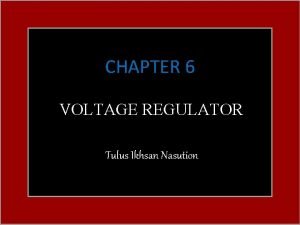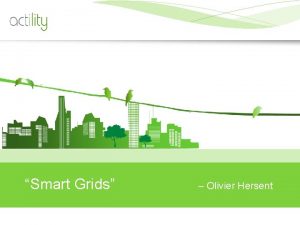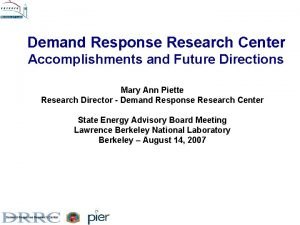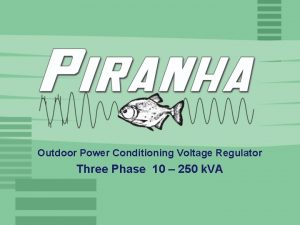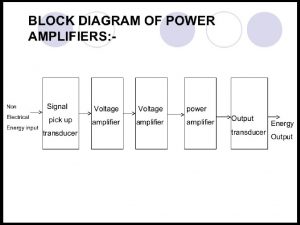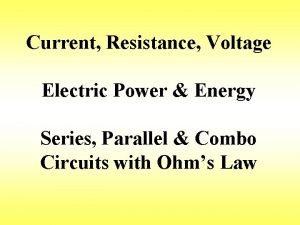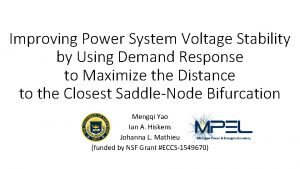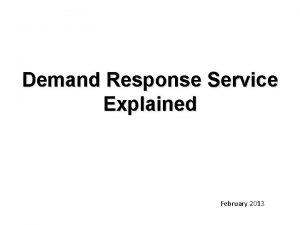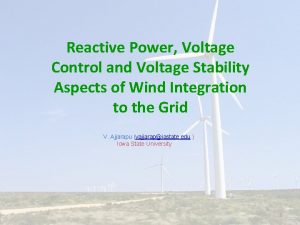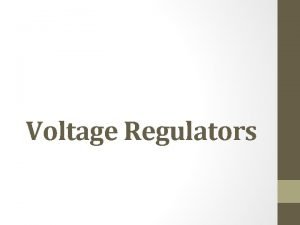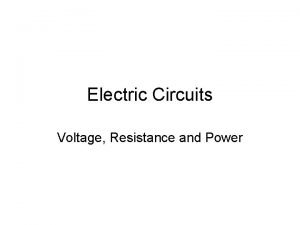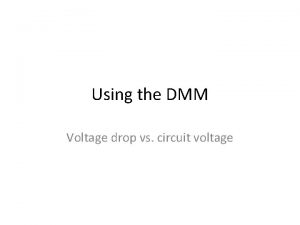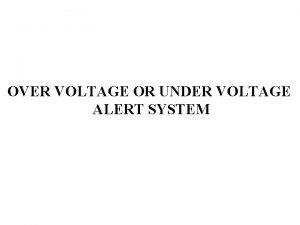Using Demand Response to Improve Power System Voltage


![Background • Power System Stability[1] • Voltage Stability • Frequency Stability • Rotor Angle Background • Power System Stability[1] • Voltage Stability • Frequency Stability • Rotor Angle](https://slidetodoc.com/presentation_image/aef2c395887c511d93eb8ff7b3c80144/image-3.jpg)
![Static Voltage Stability Margin • Loading Margin • Smallest Singular Value [2] Source: [1] Static Voltage Stability Margin • Loading Margin • Smallest Singular Value [2] Source: [1]](https://slidetodoc.com/presentation_image/aef2c395887c511d93eb8ff7b3c80144/image-4.jpg)





![SSV Maximization Problem s. t. Eigenvalue Sensitivity[1] Iterative Sensitivity Smallest Singular Value Approach [1] SSV Maximization Problem s. t. Eigenvalue Sensitivity[1] Iterative Sensitivity Smallest Singular Value Approach [1]](https://slidetodoc.com/presentation_image/aef2c395887c511d93eb8ff7b3c80144/image-10.jpg)









- Slides: 19

Using Demand Response to Improve Power System Voltage Stability Margins Mengqi Yao 1 Johanna L. Mathieu 1 Daniel K. Molzahn 2 1 University of Michigan 2 Argonne National Laboratory

Outline • Background and Motivation • Problem Description • Optimization Model • Iterative Sensitivity Smallest Singular Value Approach • Results • Conclusion and Future Work 6/21/2017 Power. Tech 2
![Background Power System Stability1 Voltage Stability Frequency Stability Rotor Angle Background • Power System Stability[1] • Voltage Stability • Frequency Stability • Rotor Angle](https://slidetodoc.com/presentation_image/aef2c395887c511d93eb8ff7b3c80144/image-3.jpg)
Background • Power System Stability[1] • Voltage Stability • Frequency Stability • Rotor Angle Stability • Demand Response (Air conditioners, Electric vehicles) • Time shifting • Spatial shifting Frequency Stability[2, 3] Voltage Stability How to use Demand Response to improve the voltage stability ? [1] P. Kundur, J. Paserba, V. Ajjarapu, G. Andersson, A. Bose, C. Canizares, N. Hatziargyriou, D. Hill, A. Stankovic, C. Taylor, T. Van, and V. Vittal, “Definition and classification of power system stability, ”, 2004 [2] J. Short, D. Infield, and L. Freris, “Stabilization of grid frequency through dynamic demand control, ”, 2007 [3] D. Callaway, “Tapping the energy storage potential in electric loads to deliver load following and regulation, with application to wind energy, ”, 2009 6/21/2017 Power. Tech 3
![Static Voltage Stability Margin Loading Margin Smallest Singular Value 2 Source 1 Static Voltage Stability Margin • Loading Margin • Smallest Singular Value [2] Source: [1]](https://slidetodoc.com/presentation_image/aef2c395887c511d93eb8ff7b3c80144/image-4.jpg)
Static Voltage Stability Margin • Loading Margin • Smallest Singular Value [2] Source: [1] S. Greene, I. Dobson, and F. L. Alvarado, “Sensitivity of the loading margin to voltage collapse with respect to arbitrary parameters, ”, 1997 [2] R. J. Thomas and A. Tiranuchit, “Voltage instabilities in electric power networks, ”, 1986 6/21/2017 Power. Tech 4

Motivation and Objective • Verify: flexible loads can also be used to improve power system static voltage stability margins. • Shifting loads in space, in order not to affect frequency stability. • Formulate an optimization model: Smallest Singular Value Power flow equations Engineering constraints 6/21/2017 Power. Tech 5

Outline • Background and Motivation • Problem Description • Optimization Model • Iterative Sensitivity Smallest Singular Value Approach • Results • Conclusion and Future Work 6/21/2017 Power. Tech 6

Problem Description Path 1: A disturbance happens X 2 X 1 3 X 4 Feasible space 6/21/2017 Path 2: Reallocate flexible load X Path 3: Generation re-dispatch; Energy pay-back Path 4: Return to initial operating point Power. Tech 7

Related Work • S. Greene, I. Dobson, and F. L. Alvarado “Sensitivity of the loading margin to voltage collapse with respect to arbitrary parameters, ”, 1997 • P. -A. Lof, T. Smed, G. Andersson, and D. Hill “Fast calculation of a voltage stability index, ”, 1992 • R. J. Avalos, C. A. Cañizares, F. Milano, and A. J. Conejo “Equivalency of continuation and optimization methods to determine saddle-node and limitinduced bifurcations in power systems”, 2009 6/21/2017 Power. Tech 8

Outline • Background and Motivation • Problem Description • Optimization Model • Iterative Sensitivity Smallest Singular Value Approach • Results • Conclusion and Future Work 6/21/2017 Power. Tech 9
![SSV Maximization Problem s t Eigenvalue Sensitivity1 Iterative Sensitivity Smallest Singular Value Approach 1 SSV Maximization Problem s. t. Eigenvalue Sensitivity[1] Iterative Sensitivity Smallest Singular Value Approach [1]](https://slidetodoc.com/presentation_image/aef2c395887c511d93eb8ff7b3c80144/image-10.jpg)
SSV Maximization Problem s. t. Eigenvalue Sensitivity[1] Iterative Sensitivity Smallest Singular Value Approach [1] L. Rouco and F. Pagola, “An eigenvalue sensitivity approach to location and controller design of controllable series capacitors for damping power system oscillations, ’’, 1997 6/21/2017 Power. Tech 10

Iterative Sensitivity Smallest Singular Value Approach Begin Solve base power flow Solve the linear optimization problem Update variables + Run AC power flow N Y Output End 6/21/2017 Power. Tech 11

Benchmark • Brute Force Smallest Singular Value Approach • Brute Force Loading Margin Approach • Optimal Loading Margin Approach[1] R. J. Avalos, C. A. Cañizares, F. Milano, and A. J. Conejo “Equivalency of continuation and optimization methods to determine saddle-node and limit-induced bifurcations in power systems”, 2009 6/21/2017 Power. Tech 12

Outline • Background and Motivation • Problem Description • Optimization Model • Iterative Sensitivity Smallest Singular Value Approach • Results • Conclusion and Future Work 6/21/2017 Power. Tech 13

Test Case: IEEE 9 -bus system 2 4 8 1 9 7 5 6 3 Smallest singular value 0. 8959 6/21/2017 Smallest singular value 0. 8995 Power. Tech 14

6/21/2017 Power. Tech 15

Test Case: IEEE 30 -bus system 6/21/2017 Power. Tech 16

Test Case: IEEE 118 -bus Computation time: 10 s 6/21/2017 Power. Tech 17

Outline • Background and Motivation • Problem Description • Optimization Model • Iterative Sensitivity Smallest Singular Value Approach • Results • Conclusion and Future Work 6/21/2017 Power. Tech 18

Conclusion • Demand response can improve static voltage stability margins • We may obtain significantly different loading patterns when we maximize different kinds of stability margins • The iterative sensitivity smallest singular value approach is able to seek the loading pattern with maximum smallest singular value Future Work • • Comparing the solution from semidefinite programming Developing strategy to pay back the energy More realistic load model Other kinds of stability margins Contact info: Mengqi Yao mqyao@umich. edu Support from NSF Grant EECS-1549670 and the U. S. DOE, Office of Electricity Delivery and Energy Reliability under contract DE-AC 02 -06 CH 11357
 Medium voltage
Medium voltage On-off control is also called as
On-off control is also called as Power formula three phase
Power formula three phase Convert rms to peak to peak
Convert rms to peak to peak The objectives of earthing is
The objectives of earthing is System.collections.generics
System.collections.generics Active power reactive power apparent power
Active power reactive power apparent power Voltage regulator types
Voltage regulator types Natural response and forced response
Natural response and forced response First order system transfer function
First order system transfer function A subsequent
A subsequent Demand response in smart grids
Demand response in smart grids Cpower demand response
Cpower demand response Demand response research center
Demand response research center Power conditioning voltage regulator with front access
Power conditioning voltage regulator with front access Voltage amplifier vs power amplifier
Voltage amplifier vs power amplifier Power with resistance and voltage
Power with resistance and voltage Negative and positive voltage from a dual power supply
Negative and positive voltage from a dual power supply Stochastic inventory model example
Stochastic inventory model example Measures to correct deficient demand
Measures to correct deficient demand







